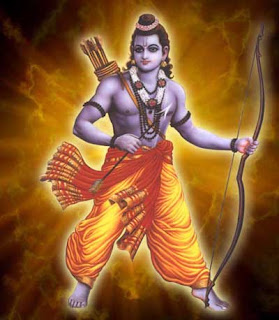Welcome back, guest writer* Gyanendra Narayan! In this day and age of obsession with the physical form, six packs, enhancements, treatments, corrections (phew!) and changing ideas of what is attractive, Gyanendra reminds us that our Scriptures have refreshing descriptions of the physical form, both male and female. Why should we look else where for an ideal of beauty? Read on. You can contact Gyanendra by leaving a comment, or on Twitter @Gyan_
Representations of Human Beauty & Physique from Sanskrit: Part- I
Notion of Tall, Dark and Handsome from Sanskrit
Description of beauty and physique has been part of literature from time immemorial. Unlike popular notions, Sanskrit is no exception to it. In fact, if one goes by chronology of literature, perhaps Sanskirt might be one of the first languages delving deep into sublime, subtle representation of human beauty and physique - notwithstanding current fashion phenomenon of tall, dark, and handsome. Sanskrit has a repository of pretty well describing shlokas about beauty and physique.
To start with, who else is better to start than the Lord Rama himself? The surprising element of Sanskrit is the detail with which it goes to talk about each part of body. I’ve selected few verses from a Sargah of Valmiki Ramayana , but would recommend readers to completely read Valmiki Ramayan, Sundar kand, 35th Sarga.
The context is: While searching for Sita, Hanumaana has arrived in Lankaa, and have managed to meet her. However Sitaa is perplexed to find a monkey with Lord Rama’s message. She is also afraid that it might be Raavana, who in the guise of well behaving monkey, wants to know about her feelings. So Sitaa is asking very probing questions about Raama (as Raavana has not seen Raama ).
In the response, Hanumaana describes physique of Lord Rama.
Sundarakaand, 35th Sargah, 23rd Sloka.
Sa suvarnacchavih srimaan Ramah shyaamo Mahaayashaa |
Taavubho narashaardulauh twaddarshankritautsawau||
Vichinwantau mahim kritsnaamsmaabhih saha sangatau|||
To maintain the context with discussion, I’m translating first line Sa: He( Lakshamn is being referred here ), suvarna-cchavih: Of golden tint/complexion Ramah: Lord Rama, shayaamo : Dark color , Mahaayashaa : Who is very famous
Here complexion of Lord Rama is being referred as dark. Isn’tit surprising that be it Rama or Sri Krishna; both have been described of dark complexion in respective literatures. In yet another shloka the same has been reemphasized.
Sundarakaand, 35th Sargah, 16th Sloka.
Dundubhiswananirghoshah snigdhavarnah prataapvaan|
Samascha suvibhaktaangauah varnam shyaamam Samaasritah||
Translating second line Samascha: All, Suvibhaktaangauh: proportionately well developed, varnam : complexion shyaamam : Dark, Samaasritah: endowed with
In this shloka also Valmiki - through Hanumaana’s narrative- is describing complexion of Lord Rama. In this shloka too Rama has been described as a person of dark complexion (definitely not fair). Moving further; one of the verses has talked about eyes of Lord Rama.
Sundarakaand, 35th Sargah, 8th Sloka.
Raamah kamalapatraakshah poornachandranibhananah|
Roopadakshinyasampannah prasuto janakaatmaje||
Translating first half of the first line Raamah: Lord Rama, kamal patraakshah : Lotus( Kamal) petals (Patraa) Akshah ( eyes)
In first line of shloka, Rama’s eyes have been compared with petals of lotus (Remember round and shining). In one of the verses height of lord Rama has been described as four arm length. Well, that’s a really great height. The shloka goes like
Sundarakaand, 35th Sargah, 18th Sloka.
Trivaliimaans-trayavanata-
Chatushkala-schaturlekh-
Translating second half of second line gives the idea of ideal height which Sanskrit Author like Risihi Valkmiki ascribes to Lord Rama’s height.
In previous shlokas also Valmiki says that Lord Rama has a deep and sound voice (Sudumbhisananirghoshah: 35th Sargah 16th shlokas) . In 15th shloka Valmiki says Lord Rama hand long hands ( Mahaabahuh ) and had heavy shoulders ( Vipulansho)
& at last, this shloka, which is shloka 20th in same sargah, should delight with detail
Dasha padmo dasha vrihat tribhih vyapto dwi shuklawaan|
Shad unnato nava tanuh tribhih vyaapnoti raghavah||
His ten(Dasha) organs are like lotus (Padmo), ten organs (dasha) are big (vrihat) . He is full of three great qualities (Tribhih vyapto), these qualities have been identified as wealth,fame,might and from both side of his parents ( dwi shuklawaan). His six organs are a bit elevated( Shad unnato) and nine organs are small( nava tanuh)
This shloka does not mention about each of those ten, ten, six and nine organs. However many reference have been found ( including transliteration of Valmiki Ramyana ) that first tens denote (, eyes, tongue, lips, palate, breasts, nails, countenance, mouth,hands and feet ), second tens denote (hest, head, forehead, neck, arms, heart, mouth, back, ears and feet), six denotes(nose, shoulders, flanks, abdomen, breast, and the forehead) and last nine denote( hair, moustaches and beard, nails, hair on the body, skin, finger-joints, membrum virile, acumen and perception). You can’t have any poet describing more than this.
A handsome person cannot be described in more detailed way than this.
There are many references to physique of Lord Rama and in fact many other literature in Sanskrit have detailed about physical beauty. All references which I have taken belong to just half Sarga( sub-chapter ) of Valmiki Ramayana.
Chances are you will not find any sophisticated, well written, more detailed and authentic piece of a person physique than what Valmiki has described.
Disclaimer: This article is by no mean to demean/defame any religion/god as me myself is a professed devout. This article is an attempt to find the description of beauty, physique and masculinity in Sanskrit literature. It is as well an attempt to break the pre-conceived notion of description of beauty, “Saundarya” being domain of any particular or foreign language.
* The views of guest writers is their own. I may or may not agree with them, but I respect their right to be heard.


